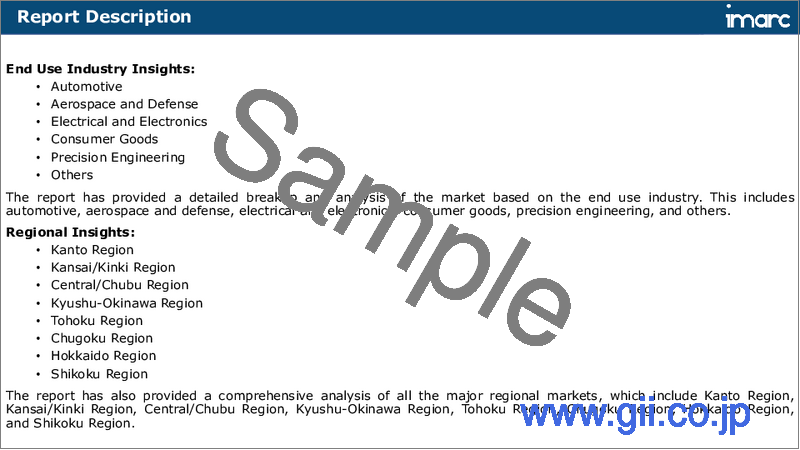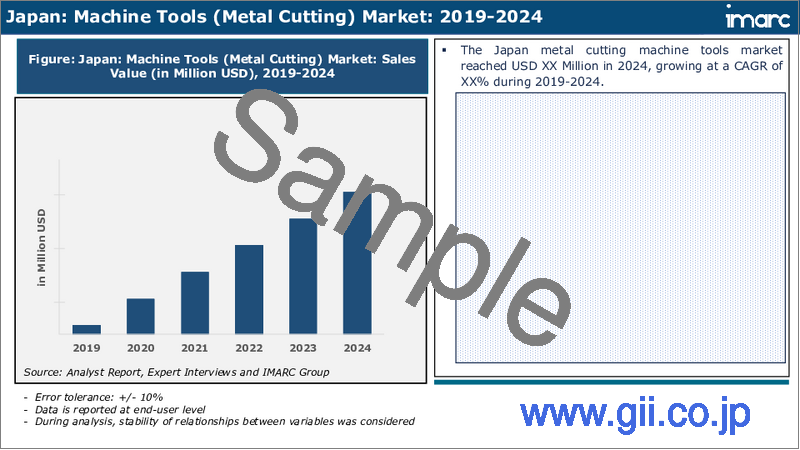|
|
市場調査レポート
商品コード
1747139
日本の工作機械市場:工作タイプ、技術タイプ、最終用途産業、地域別市場規模、シェア、動向、予測、2025~2033年Japan Machine Tools Market Size, Share, Trends and Forecast by Tool Type, Technology Type, End Use Industry, and Region, 2025-2033 |
||||||
カスタマイズ可能
|
|||||||
| 日本の工作機械市場:工作タイプ、技術タイプ、最終用途産業、地域別市場規模、シェア、動向、予測、2025~2033年 |
|
出版日: 2025年06月02日
発行: IMARC
ページ情報: 英文 115 Pages
納期: 5~7営業日
|
- 全表示
- 概要
- 目次
日本の工作機械市場規模は2024年に62億1,570万米ドルに達しました。今後、IMARC Groupは、同市場が2033年までに88億870万米ドルに達し、2025~2033年の成長率(CAGR)は3.95%になると予測しています。市場は、自動車と航空宇宙セクタからの旺盛な需要、自動化導入の増加、精密製造ニーズ、輸出の拡大、継続的な技術進歩、支持的な政府施策、スマート工場構想への投資の増加によって牽引されます。
本レポートで扱う主要質問
- 日本の工作機械市場はこれまでどのように推移し、今後どのように推移するのか?
- 日本の工作機械市場の工作タイプ別区分は?
- 日本の工作機械市場の技術タイプ別区分は?
- 日本の工作機械市場の最終用途産業別区分は?
- 日本の工作機械市場の地域別区分は?
- 日本の工作機械市場のバリューチェーンにおける様々なステージとは?
- 日本の工作機械の主要な促進要因と課題は?
- 日本の工作機械市場の構造と主要参入企業は?
- 日本の工作機械市場における競合の程度は?
目次
第1章 序文
第2章 調査範囲と調査手法
- 調査の目的
- ステークホルダー
- データソース
- 市場推定
- 調査手法
第3章 エグゼクティブサマリー
第4章 日本の工作機械市場-イントロダクション
- 概要
- 市場力学
- 産業動向
- 競合情報
第5章 日本の工作機械市場情勢
- 過去と現在の市場動向(2019~2024年)
- 市場予測(2025~2033年)
第6章 日本の工作機械市場-工作タイプ別内訳
- 金属切削
- 金属成形
- 付属品
第7章 日本の工作機械市場-技術タイプ別内訳
- 従来型
- CNC(コンピュータ数値制御)
第8章 日本の工作機械市場-最終用途産業別内訳
- 自動車
- 航空宇宙と防衛
- 電気・電子工学
- 消費財
- 精密工学
- その他
第9章 日本の工作機械市場-競合情勢
- 概要
- 市場構造
- 市場企業のポジショニング
- 主要成功戦略
- 競合ダッシュボード
- 企業評価象限
第10章 主要企業のプロファイル
第11章 日本の工作機械市場-産業分析
- 促進要因・抑制要因・機会
- ポーターのファイブフォース分析
- バリューチェーン分析
第12章 付録
The Japan machine tools market size reached USD 6,215.7 Million in 2024. Looking forward, IMARC Group expects the market to reach USD 8,808.7 Million by 2033, exhibiting a growth rate (CAGR) of 3.95% during 2025-2033. The market is driven by strong demand from the automotive and aerospace sectors, rising automation adoption, precision manufacturing needs, expanding exports, ongoing technological advancements, supportive government policies, and increasing investments in smart factory initiatives.
Japan Machine Tools Market Trends:
Shift Toward Smart Manufacturing and Automation
The Japan machine tools market is expanding due to the emerging use of smart manufacturing and automation technologies. The production lines receive advanced robotics and artificial intelligence (AI)-driven systems and Internet of Things (IoT)-enabled equipment from manufacturers to boost efficiency and precision and enhance flexibility. For instance, at JIMTOF 2024, DMG MORI emphasized its focus on AI applications, including parts measurement and predictive maintenance, enhancing automation and process integration in machine tools. Moreover, the industry has entered the Fourth Industrial Revolution by adopting live data tracking and predictive service methods as standard operations. Besides this, new machine tools support customized production needs and quick delivery times which makes them vital for businesses to maintain manufacturing agility. Also, the investment in digital retrofitting of existing manufacturing equipment instead of system replacement allows businesses to cut down expenses and enhance operational performance. Furthermore, Japan continues to build its international leadership in manufacturing through the growing market need for automated machines able to detect and solve problems independently while preserving its reputation for technological excellence. As a result, the approach significantly strengthens business competitiveness and tackles labor shortages because it decreases the need for manual precision work, thus driving the Japan machine tools market growth.
Rising Demand from High-Precision Industries
The rising demand from high-precision industries such as aerospace and medical devices is boosting the Japan machine tools market share. In line with this, the market demands instrument tools that precisely process complex forms and handle difficult material types. Moreover, the market demonstrates rising interest in three-axis machining centers combined with high-speed milling and advanced measurement technologies. Besides this, manufacturers are advancing the accuracy and surface finish capabilities are enabling new developments in tool design elements and control software development alongside spindle technology improvements. Concurrently, the reduction of electronic and medical device parts calls for the continuous advancement of micro-machining technologies. Additionally, the production of high-end precision machine tools with durability and accuracy enables Japan to maintain its leadership position globally. For example, in December 2024, Nidec Corporation announced a ¥257 billion tender offer for Makino Milling Machine Co., aiming to enhance its capabilities in high-precision machining equipment, crucial for aerospace and medical device manufacturing. Furthermore, partnerships between machine tool makers and high-tech industries are increasing as they collaborate to develop specific equipment together. Apart from this, global shifts in product quality standards create strong market potential for Japan to use its precision-engineered solution expertise because of its strategic position, thereby enhancing the Japan machine tools market outlook.
Japan Machine Tools Market Segmentation:
Tool Type Insights:
- Metal Cutting
- Metal Forming
- Accessories
Technology Type Insights:
- Conventional
- CNC (Computerized Numerical Control)
End Use Industry Insights:
- Automotive
- Aerospace and Defense
- Electrical and Electronics
- Consumer Goods
- Precision Engineering
- Others
Competitive Landscape:
The market research report has also provided a comprehensive analysis of the competitive landscape. Competitive analysis such as market structure, key player positioning, top winning strategies, competitive dashboard, and company evaluation quadrant has been covered in the report. Also, detailed profiles of all major companies have been provided.
Key Questions Answered in This Report:
- How has the Japan machine tools market performed so far and how will it perform in the coming years?
- What is the breakup of the Japan machine tools market on the basis of tool type?
- What is the breakup of the Japan machine tools market on the basis of technology type?
- What is the breakup of the Japan machine tools market on the basis of end use industry?
- What is the breakup of the Japan machine tools market on the basis of region?
- What are the various stages in the value chain of the Japan machine tools market?
- What are the key driving factors and challenges in the Japan machine tools?
- What is the structure of the Japan machine tools market and who are the key players?
- What is the degree of competition in the Japan machine tools market?
Table of Contents
1 Preface
2 Scope and Methodology
- 2.1 Objectives of the Study
- 2.2 Stakeholders
- 2.3 Data Sources
- 2.3.1 Primary Sources
- 2.3.2 Secondary Sources
- 2.4 Market Estimation
- 2.4.1 Bottom-Up Approach
- 2.4.2 Top-Down Approach
- 2.5 Forecasting Methodology
3 Executive Summary
4 Japan Machine Tools Market - Introduction
- 4.1 Overview
- 4.2 Market Dynamics
- 4.3 Industry Trends
- 4.4 Competitive Intelligence
5 Japan Machine Tools Market Landscape
- 5.1 Historical and Current Market Trends (2019-2024)
- 5.2 Market Forecast (2025-2033)
6 Japan Machine Tools Market - Breakup by Tool Type
- 6.1 Metal Cutting
- 6.1.1 Overview
- 6.1.2 Historical and Current Market Trends (2019-2024)
- 6.1.3 Market Forecast (2025-2033)
- 6.2 Metal Forming
- 6.2.1 Overview
- 6.2.2 Historical and Current Market Trends (2019-2024)
- 6.2.3 Market Forecast (2025-2033)
- 6.3 Accessories
- 6.3.1 Overview
- 6.3.2 Historical and Current Market Trends (2019-2024)
- 6.3.3 Market Forecast (2025-2033)
7 Japan Machine Tools Market - Breakup by Technology Type
- 7.1 Conventional
- 7.1.1 Overview
- 7.1.2 Historical and Current Market Trends (2019-2024)
- 7.1.3 Market Forecast (2025-2033)
- 7.2 CNC (Computerized Numerical Control)
- 7.2.1 Overview
- 7.2.2 Historical and Current Market Trends (2019-2024)
- 7.2.3 Market Forecast (2025-2033)
8 Japan Machine Tools Market - Breakup by End Use Industry
- 8.1 Automotive
- 8.1.1 Overview
- 8.1.2 Historical and Current Market Trends (2019-2024)
- 8.1.3 Market Forecast (2025-2033)
- 8.2 Aerospace and Defense
- 8.2.1 Overview
- 8.2.2 Historical and Current Market Trends (2019-2024)
- 8.2.3 Market Forecast (2025-2033)
- 8.3 Electrical and Electronics
- 8.3.1 Overview
- 8.3.2 Historical and Current Market Trends (2019-2024)
- 8.3.3 Market Forecast (2025-2033)
- 8.4 Consumer Goods
- 8.4.1 Overview
- 8.4.2 Historical and Current Market Trends (2019-2024)
- 8.4.3 Market Forecast (2025-2033)
- 8.5 Precision Engineering
- 8.5.1 Overview
- 8.5.2 Historical and Current Market Trends (2019-2024)
- 8.5.3 Market Forecast (2025-2033)
- 8.6 Others
- 8.6.1 Historical and Current Market Trends (2019-2024)
- 8.6.2 Market Forecast (2025-2033)
9 Japan Machine Tools Market - Competitive Landscape
- 9.1 Overview
- 9.2 Market Structure
- 9.3 Market Player Positioning
- 9.4 Top Winning Strategies
- 9.5 Competitive Dashboard
- 9.6 Company Evaluation Quadrant
10 Profiles of Key Players
- 10.1 Company A
- 10.1.1 Business Overview
- 10.1.2 Products Offered
- 10.1.3 Business Strategies
- 10.1.4 SWOT Analysis
- 10.1.5 Major News and Events
- 10.2 Company B
- 10.2.1 Business Overview
- 10.2.2 Products Offered
- 10.2.3 Business Strategies
- 10.2.4 SWOT Analysis
- 10.2.5 Major News and Events
- 10.3 Company C
- 10.3.1 Business Overview
- 10.3.2 Products Offered
- 10.3.3 Business Strategies
- 10.3.4 SWOT Analysis
- 10.3.5 Major News and Events
- 10.4 Company D
- 10.4.1 Business Overview
- 10.4.2 Products Offered
- 10.4.3 Business Strategies
- 10.4.4 SWOT Analysis
- 10.4.5 Major News and Events
- 10.5 Company E
- 10.5.1 Business Overview
- 10.5.2 Products Offered
- 10.5.3 Business Strategies
- 10.5.4 SWOT Analysis
- 10.5.5 Major News and Events
11 Japan Machine Tools Market - Industry Analysis
- 11.1 Drivers, Restraints, and Opportunities
- 11.1.1 Overview
- 11.1.2 Drivers
- 11.1.3 Restraints
- 11.1.4 Opportunities
- 11.2 Porters Five Forces Analysis
- 11.2.1 Overview
- 11.2.2 Bargaining Power of Buyers
- 11.2.3 Bargaining Power of Suppliers
- 11.2.4 Degree of Competition
- 11.2.5 Threat of New Entrants
- 11.2.6 Threat of Substitutes
- 11.3 Value Chain Analysis






